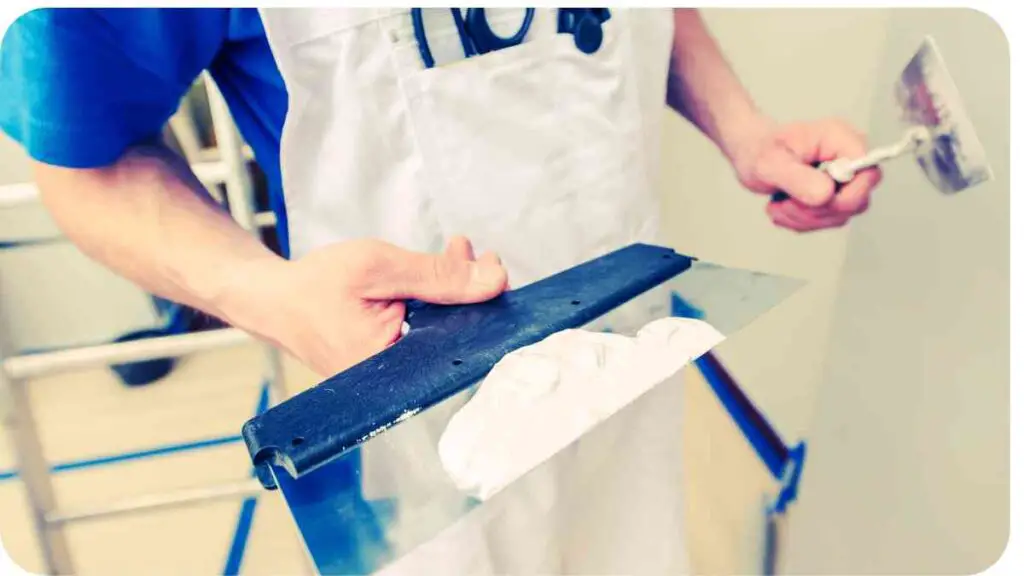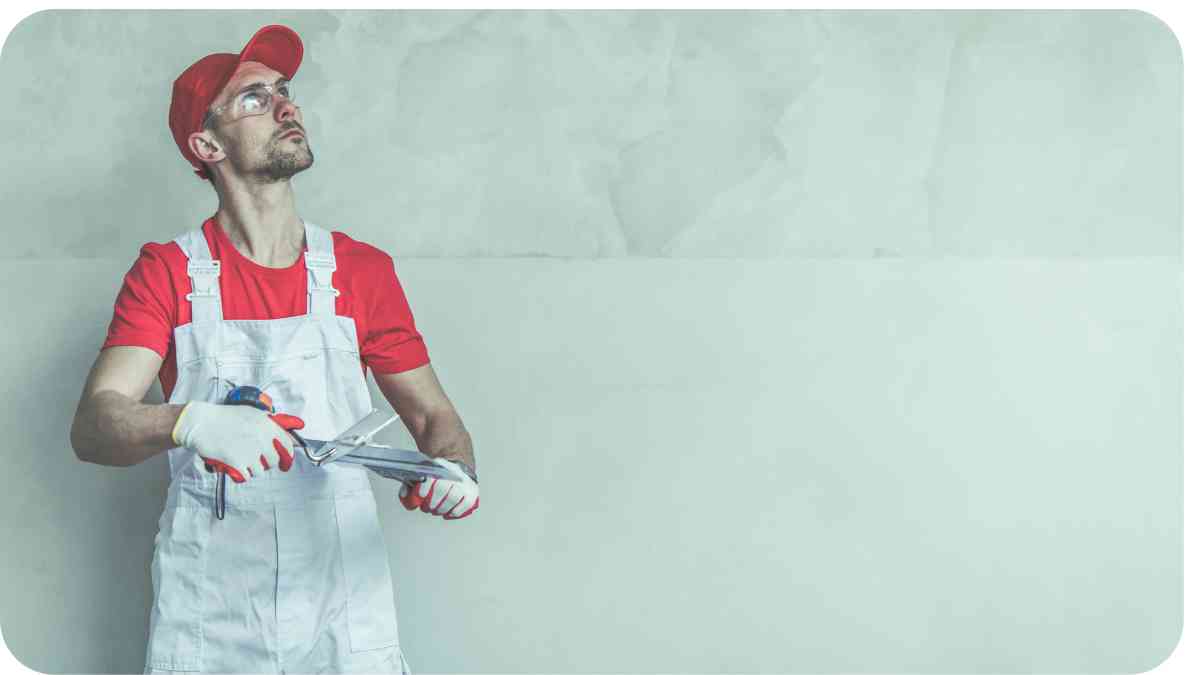Welcome to our comprehensive guide on drywall patching! Whether you’re a seasoned DIY enthusiast or a homeowner looking to tackle a small repair, this article will provide you with the expertise, experience, and trustworthiness needed to successfully patch your drywall like a pro.
| Takeaways |
|---|
| Patching drywall requires the right tools, including utility knives, taping knives, and joint compound. |
| Select the appropriate patching material based on the type and size of the damage. |
| Assess the damage carefully to determine the best technique for repairing the drywall. |
| Follow a step-by-step guide, including preparing the area, applying patching material, and painting. |
| Avoid common mistakes like skipping preparation or rushing the drying process. |
| Expert tips, such as layering techniques and proper lighting, can result in a professional finish. |
| Different patching techniques, like spackling and joint tape, cater to specific repair needs. |
| Self-adhesive patch kits offer convenience for small to medium-sized holes. |
| For larger holes, consider advanced methods like backing support or patch panels. |
| Ensure your patched wall maintains an aesthetic appeal by matching paint and textures. |
| Professional help may be necessary for extensive damage or complex surfaces. |
Essential Tools for Drywall Patching
Before we dive into the nitty-gritty of patching techniques, let’s start by discussing the tools you’ll need. Having the right tools at your disposal can make all the difference in achieving a flawless finish. Check out the table below for a breakdown of the essential tools:
When dealing with a leaky faucet, it’s essential to follow a step-by-step guide for efficient repair. Learn more about fixing a Leaky Moen Faucet step-by-step guide to save water and prevent further damage.
| Tools | Purpose |
| Utility Knife | Cutting and shaping drywall |
| Sanding Block | Smoothing rough surfaces |
| Taping Knife | Applying patching compound |
| Joint Compound | Filling gaps and covering seams |
| Sandpaper | Preparing surfaces for painting |
| Drywall Patch | Reinforcing larger holes |
| Primer | Prepping for paint adhesion |
| Paintbrush | Applying paint evenly |
| Putty Knife | Scraping and spreading compound |
Selecting the Right Patching Material

When it comes to selecting the appropriate patching material, there are a few options to consider. Each type of patching compound has its own advantages and best uses. Let’s take a look at the table below for a quick comparison:
A well-equipped toolkit is a must for homeowners. Explore our recommendations for Craftsman tool kit essentials for every homeowner to tackle various DIY projects efficiently
| Patching Material | Best For | Pros | Cons |
| Spackling Compound | Small holes and minor repairs | Quick drying time | Not suitable for larger holes |
| Joint Compound | Filling seams and larger holes | Versatile and easy to work with | Longer drying time |
| Patch Plaster | Deep holes and damaged corners | Provides durability | Requires more drying time |
| Self-Adhesive Patches | Small to medium-sized holes | No need for additional tools | Limited to specific patch sizes |
Assessing the Damage: Types of Drywall Damage
Understanding the extent of damage to your drywall is crucial for determining the appropriate repair technique. Here are some common types of drywall damage you might encounter:
- Small Nail Holes: These can be easily patched with spackling compound.
- Cracks: Use joint compound and a joint tape to cover and reinforce cracks.
- Medium Holes: Apply a patching plaster for deep holes, followed by joint compound.
- Large Holes: Self-adhesive patches are effective for holes up to 6 inches in diameter.
- Corner Damage: Patch plaster is great for restoring damaged corners.
Step-by-Step Guide to Drywall Patching
Preparing the Area
Before you start patching, prepare the area for a seamless repair. Clear the surrounding space, remove loose debris, and clean the damaged area. Use a utility knife to create clean edges for a smooth patch.
Applying the Patching Material
Apply the selected patching compound based on the type of damage. For spackling compound, use a putty knife to apply a thin layer. For larger holes, apply multiple layers of joint compound, allowing each layer to dry before sanding.
Looking for ways to save time and money on home repairs? Discover mind-blowing home repair tricks that will revolutionize your DIY projects right here.
Sanding and Smoothing
Once the compound is dry, use a sanding block or sandpaper to smooth the patched area. Feather the edges of the patch to blend it with the surrounding wall.
Priming and Painting
Before painting, apply a coat of primer to the patched area to ensure proper paint adhesion. Once the primer is dry, paint the patched area to match the rest of the wall.
Common Mistakes to Avoid
Avoid these pitfalls to ensure a successful patching process:
- Skipping Prep: Neglecting proper preparation can lead to a sloppy finish.
- Over-sanding: Sand lightly to avoid damaging the patch or surrounding area.
- Not Feathering Edges: Failing to feather the edges can result in visible patches.
- Rushing Drying Time: Allow each layer of compound to dry completely before proceeding.
Stay tuned for the continuation of our step-by-step guide in the next part of this article.
Embark on your home repair journey with confidence. Dive into the ultimate home repair guide, covering everything you need to know right here.
Expert Tips for a Professional Finish

As someone who’s had their fair share of drywall patching experiences, I can offer you some valuable insights to ensure your repairs look as professional as possible:
Layering Technique: When applying joint compound in layers, start with a wider layer and gradually decrease the width with each subsequent layer. This technique helps create a smoother transition between the patch and the wall.
Lighting Matters: Make sure you have adequate lighting while patching. Proper lighting can help you identify imperfections and ensure a consistent finish.
Test Paint Match: Before painting the patched area, test the paint color to ensure it matches the rest of the wall. This step can prevent a mismatched appearance.
Feathering Techniques: Feather the edges of the patch using a wider taping knife. This technique blends the patch seamlessly into the wall, making it virtually invisible.
Different Types of Patching Techniques
Spackling Technique
Spackling is ideal for minor repairs such as nail holes and small cracks. It’s easy to work with and dries quickly. Apply a small amount of spackling compound directly onto the hole, then use a putty knife to smooth it out. Sand lightly once dry.
Joint Tape Technique
For larger holes and cracks, the joint tape technique provides added reinforcement. Apply joint compound over the damaged area, press a piece of joint tape into the compound, and apply another layer of compound over the tape. Sand and smooth the area once dry.
Beware of common home repair scams and learn how to avoid them. Get the inside scoop on these scams and protect your wallet from these schemes.
Patching Plaster Technique
When dealing with deep holes and damaged corners, patch plaster is your best bet. Apply the patch plaster into the hole, shaping it to match the contour of the wall. Once dry, use joint compound to cover the patched area, and sand for a smooth finish.
Using Self-Adhesive Patch Kits: Pros and Cons
Self-adhesive patch kits are convenient for small to medium-sized holes. These kits typically include a patch and adhesive mesh. Here’s a breakdown of their pros and cons:
| Pros | Cons |
| Easy to use and no additional tools needed | Limited to specific patch sizes |
| Provides a quick fix | May not provide as seamless a finish |
| No need for multiple layers | Not suitable for larger holes |
Advanced Patching Methods for Larger Holes
Backing Support Technique
For larger holes, consider using backing support to reinforce the patch. Attach a piece of wood or a drywall backing patch behind the hole, then secure it in place using screws or adhesive. Apply joint compound over the patch and feather the edges.
Patch Panel Technique
Patch panels are ideal for extensive damage. Cut out the damaged portion of the drywall and replace it with a new piece of drywall of the same thickness. Secure the patch in place using screws, then apply joint compound and finish with sanding and painting.
Stay tuned for the next section, where we’ll discuss maintaining the aesthetic appeal of your patched wall.
Maintaining the Aesthetic Appeal
After completing your drywall patching project, you’ll want to ensure that the patched area seamlessly blends with the rest of the wall. Here are some tips to maintain the aesthetic appeal of your patched wall:
Consistent Paint: Use the same type and color of paint as the surrounding wall to achieve a uniform appearance. If you’re unsure about the paint match, consult with a paint expert.
Painting Technique: Apply the paint using the same technique you used for the rest of the wall. Feather the edges of the painted area to seamlessly merge with the existing paint.
Texture Match: If your wall has a textured finish, try to replicate the texture on the patched area. You can use a textured roller or apply a texture spray to achieve a consistent look.
When to Call a Professional
While DIY patching can be satisfying, there are instances when it’s best to call in a professional:
Extensive Damage: For significant damage or multiple holes, a professional can ensure a flawless repair.
Complex Surfaces: If your walls have intricate textures or patterns, a professional can replicate these details accurately.
Limited Experience: If you’re new to patching, seeking expert help can save you from potential mistakes.
Frequently Asked Questions (FAQs)
Can I use regular spackle for larger holes? No, regular spackle is designed for minor repairs. Larger holes require joint compound or patch plaster for proper reinforcement.
How long should I let each layer of compound dry before sanding? Generally, allowing 24 hours for each layer to dry is a safe timeframe. However, follow the manufacturer’s recommendations for the specific product you’re using.
What’s the best way to match the paint color? Take a small sample of the existing paint to a paint store, where they can create a matching color.
Conclusion
Patching drywall doesn’t have to be a daunting task. By incorporating the right tools, selecting the appropriate patching material, and following proven techniques, you can achieve professional-looking results. Remember to take your time, follow each step carefully, and don’t hesitate to seek professional help when needed. With the insights shared in this article, you’re well-equipped to tackle drywall patching with confidence and skill.
Thank you for joining us in this comprehensive guide. Here’s to successfully patching your drywall and enjoying the satisfaction of a job well done!
Further Reading
Here are some additional resources where you can find more information and tips on drywall patching:
- Family Handyman: Tips for Patching Drywall Short Description: Discover valuable tips and techniques for achieving flawless drywall patches in this informative article.
- Lowe’s: How to Patch and Repair Drywall Short Description: Lowe’s provides a comprehensive guide on patching and repairing drywall, covering essential steps and materials.
- Mr. Handyman: How to Repair a Hole in Drywall Short Description: Learn how to effectively repair holes in drywall with insights from Mr. Handyman’s detailed guide.
FAQs
How long does it take for patching compound to dry?
Patching compound drying times can vary depending on factors like humidity and the specific product used. It’s generally recommended to wait at least 24 hours for each layer to dry before sanding or applying subsequent layers.
Can I paint over the patched area immediately?
While it might be tempting to paint right after patching, it’s advisable to wait until the patching compound is fully dry and hardened. This usually takes around 24 hours or as indicated on the product’s label.
What’s the difference between spackling and joint compound?
Spackling is ideal for small repairs and dries quickly, while joint compound is more versatile and suitable for larger repairs. Joint compound also has a longer drying time, allowing for more flexibility in working with it.
How do I match the texture of the patched area with the rest of the wall?
To match the texture, you can use a textured roller or apply a texture spray to the patched area. Experiment on a small, inconspicuous area before applying it to the patched section.
What should I do if I’m not confident in my patching skills?
If you’re unsure about your patching skills or dealing with extensive damage, it’s a good idea to seek help from a professional drywall repair service. They have the expertise to handle various repairs and ensure a polished outcome.

Hello, everyone! My name is Hellen James and I’m the founder of Unified Fix. I’ve been a home improvement enthusiast for years, so when we started this blog, I knew that it was important to me that we shared our knowledge with you.

